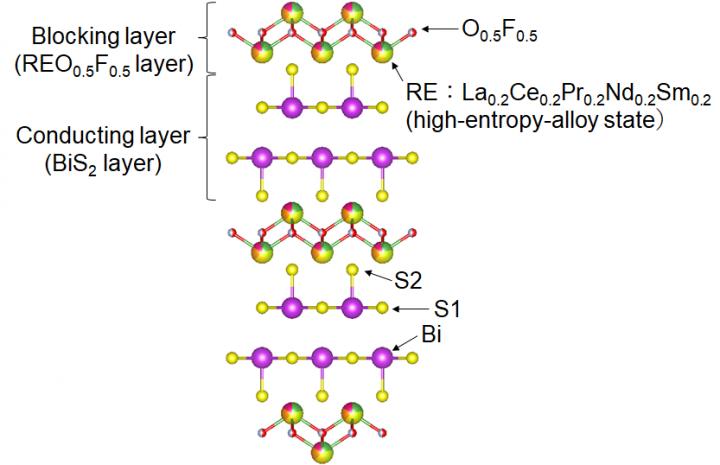

This is a schematic image of the crystal structure of high-entropy-alloy-type REO0.5F0.5BiS2.
Credit: Yoshikazu Mizuguchi
Researchers from Tokyo Metropolitan University have created new superconductors made of layers of bismuth sulfide (BiS2) and a high entropy rare earth alloy oxyfluoride, containing five different rare earth (RE) elements at the same crystallographic site.
The new material retains superconducting properties over a wider range of lattice parameters than materials without high-entropy-alloy states. Their work promises an exciting new strategy for designing new layered superconductors, a potentially key development in the search for high-temperature superconductors.
Superconductors are key to a range of exciting potential applications. For example, zero resistivity promises loss-free power transmission and powerful electromagnets. The challenge has been to discover a material that retains this property at higher temperatures, closer to ambient temperatures. Despite focused work and a number of breakthroughs in recent years, the hunt is still on for effective strategies to create new superconducting materials.
One strategy is the use of layered materials with a molecular structure consisting of alternating superconducting layers and “blocking layers” acting as insulating spacers. A team led by Associate Professor Yoshikazu Mizuguchi from the Department of Physics, Tokyo Metropolitan University, has uncovered an important aspect of designing the insulating layer.
They were able to combine five different rare earth (RE) elements, lanthanum, cerium, praseodymium, neodymium, and samarium, and create a “high entropy alloy” in the blocking layer. High entropy alloys have attracted considerable attention in recent years for their toughness, resistance to fatigue and ductility, amongst many other notable physical properties.
The team's new materials, with different proportions of REs (10-30%), exhibited enhanced superconducting properties; in particular, materials with the same period in their molecular structure exhibited a superconducting transition at higher temperatures when the blocking layer contained a high entropy alloy. They believe that the high entropy alloy helps to stabilize the crystal structure of the superconducting layer.
The work's impact is not limited to the new materials they present. Given the existence of a large number of superconducting layers which are compatible with RE oxides, this innovation opens the way for a broad new strategy for engineering new, revolutionary superconducting materials.
###
This study was supported by a JSPS KAKENHI Grant on Innovative Areas (J-Physics) and a Grant-in-Aid for Scientific Research (B). The manuscript reporting this finding has been published online in Applied Physics Express (APEX).












